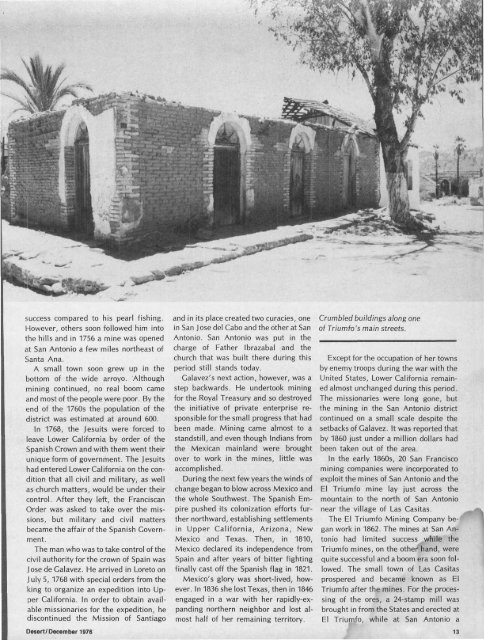1 - Desert Magazine of the Southwest
1 - Desert Magazine of the Southwest
1 - Desert Magazine of the Southwest
You also want an ePaper? Increase the reach of your titles
YUMPU automatically turns print PDFs into web optimized ePapers that Google loves.
success compared to his pearl fishing.<br />
However, o<strong>the</strong>rs soon followed him into<br />
<strong>the</strong> hills and in 1756 a mine was opened<br />
at San Antonio a few miles nor<strong>the</strong>ast <strong>of</strong><br />
Santa Ana.<br />
A small town soon grew up in <strong>the</strong><br />
bottom <strong>of</strong> <strong>the</strong> wide arroyo. Although<br />
mining continued, no real boom came<br />
and most <strong>of</strong> <strong>the</strong> people were poor. By <strong>the</strong><br />
end <strong>of</strong> <strong>the</strong> 1760s <strong>the</strong> population <strong>of</strong> <strong>the</strong><br />
district was estimated at around 600.<br />
In 1768, <strong>the</strong> Jesuits were forced to<br />
leave Lower California by order <strong>of</strong> <strong>the</strong><br />
Spanish Crown and with <strong>the</strong>m went <strong>the</strong>ir<br />
unique form <strong>of</strong> government. The Jesuits<br />
had entered Lower California on <strong>the</strong> condition<br />
that all civil and military, as well<br />
as church matters, would be under <strong>the</strong>ir<br />
control. After <strong>the</strong>y left, <strong>the</strong> Franciscan<br />
Order was asked to take over <strong>the</strong> missions,<br />
but military and civil matters<br />
became <strong>the</strong> affair <strong>of</strong> <strong>the</strong> Spanish Government.<br />
The man who was to take control <strong>of</strong> <strong>the</strong><br />
civil authority for <strong>the</strong> crown <strong>of</strong> Spain was<br />
Jose de Calavez. He arrived in Loreto on<br />
I uly 5, 1768 with special orders from <strong>the</strong><br />
king to organize an expedition into Upper<br />
California. In order to obtain available<br />
missionaries for <strong>the</strong> expedition, he<br />
discontinued <strong>the</strong> Mission <strong>of</strong> Santiago<br />
<strong>Desert</strong>/December 1976<br />
and in its place created two curacies, one<br />
in San Jose del Caboand <strong>the</strong> o<strong>the</strong>r at San<br />
Antonio. San Antonio was put in <strong>the</strong><br />
charge <strong>of</strong> Fa<strong>the</strong>r Ibrazabal and <strong>the</strong><br />
church that was built <strong>the</strong>re during this<br />
period still stands today.<br />
Galavez's next action, however, was a<br />
step backwards. He undertook mining<br />
for <strong>the</strong> Royal Treasury and so destroyed<br />
<strong>the</strong> initiative <strong>of</strong> private enterprise responsible<br />
for <strong>the</strong> small progress that had<br />
been made. Mining came almost to a<br />
standstill, and even though Indians from<br />
<strong>the</strong> Mexican mainland were brought<br />
over to work in <strong>the</strong> mines, little was<br />
accomplished.<br />
During <strong>the</strong> next few years <strong>the</strong> winds <strong>of</strong><br />
change began to blow across Mexico and<br />
<strong>the</strong> whole <strong>Southwest</strong>. The Spanish Empire<br />
pushed its colonization efforts fur<strong>the</strong>r<br />
northward, establishing settlements<br />
in Upper California, Arizona, New<br />
Mexico and Texas. Then, in 1810,<br />
Mexico declared its independence from<br />
Spain and after years <strong>of</strong> bitter fighting<br />
finally cast <strong>of</strong>f <strong>the</strong> Spanish flag in 1821.<br />
Mexico's glory was short-lived, however.<br />
In 1836 she lost Texas, <strong>the</strong>n in 1846<br />
engaged in a war with her rapidly-expanding<br />
nor<strong>the</strong>rn neighbor and lost almost<br />
half <strong>of</strong> her remaining territory.<br />
Crumbled buildings along one<br />
<strong>of</strong> Triumfo's main streets.<br />
Except for <strong>the</strong> occupation <strong>of</strong> her towns<br />
by enemy troops during <strong>the</strong> war with <strong>the</strong><br />
United States, Lower California remained<br />
almost unchanged during this period.<br />
The missionaries were long gone, but<br />
<strong>the</strong> mining in <strong>the</strong> San Antonio district<br />
continued on a small scale despite <strong>the</strong><br />
setbacks <strong>of</strong> Galavez. It was reported that<br />
by 1860 just under a million dollars had<br />
been taken out <strong>of</strong> <strong>the</strong> area.<br />
In <strong>the</strong> early 1860s, 20 San Francisco<br />
mining companies were incorporated to<br />
exploit <strong>the</strong> mines <strong>of</strong> San Antonio and <strong>the</strong><br />
El Triumfo mine lay just across <strong>the</strong><br />
mountain to <strong>the</strong> north <strong>of</strong> San Antonio<br />
near <strong>the</strong> village <strong>of</strong> Las Casitas.<br />
The El Triumfo Mining Company began<br />
work in 1862. The mines at San Antonio<br />
had limited success while <strong>the</strong><br />
Triumfo mines, on <strong>the</strong> o<strong>the</strong>r hand, were<br />
quite successful and a boom era soon followed.<br />
The small town <strong>of</strong> Las Casitas<br />
prospered and became known as El<br />
Triumfo after <strong>the</strong> mines. For <strong>the</strong> processing<br />
<strong>of</strong> <strong>the</strong> ores, a 24-stamp mill was<br />
brought in from <strong>the</strong> States and erected at<br />
El Triumfo, while at San Antonio a<br />
13

















